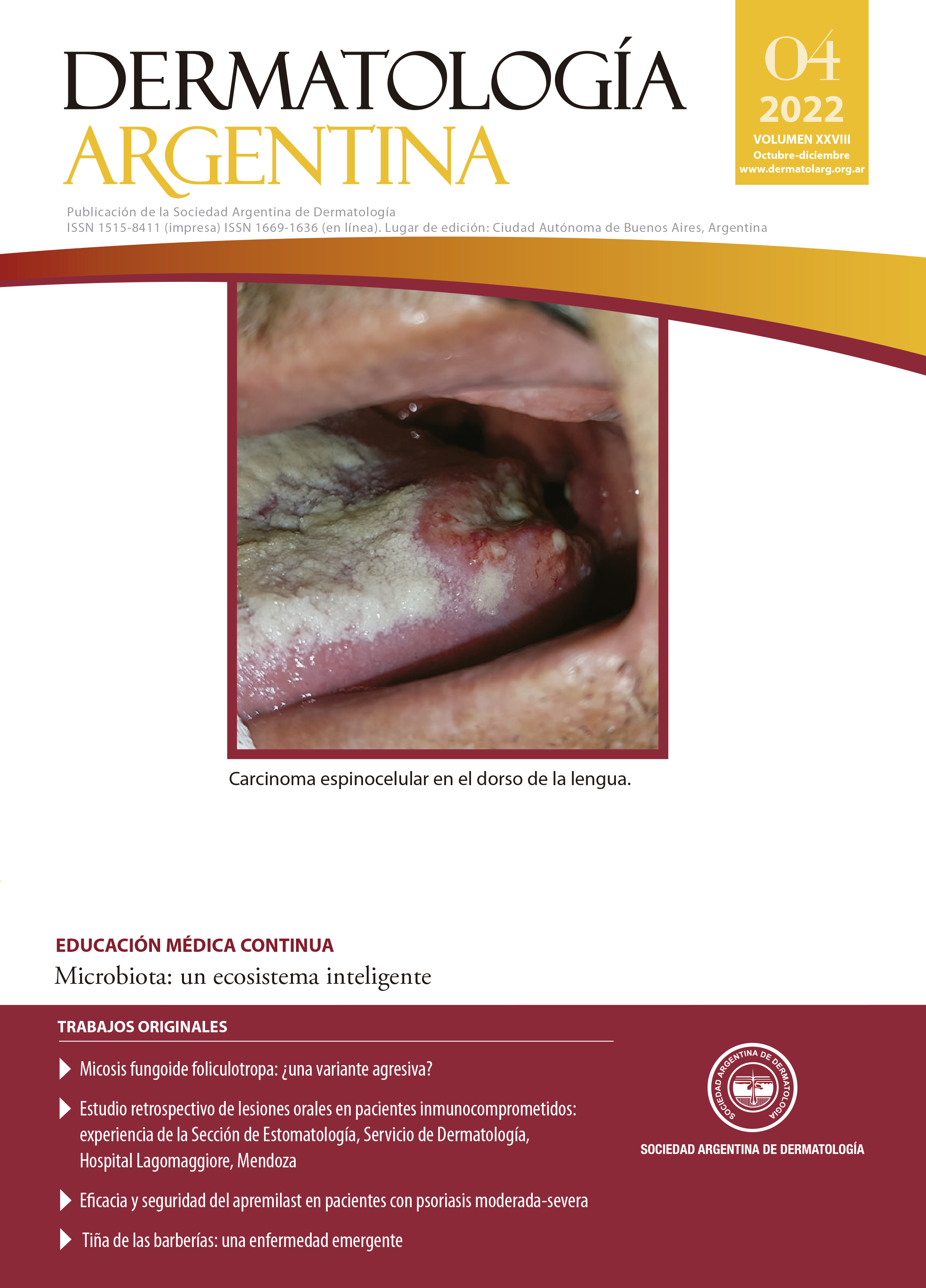Barber’s shop-adquired tinea: an emerging disease
DOI:
https://doi.org/10.47196/da.v28i4.2406Keywords:
dermatophytosis, tinea capitis, Trichophyton tonsurans, Kerion celsi, barber’s shop tineaAbstract
Background: tinea capitis is a dermatophytosis of the scalp. It is caused by dermatophytes such as Microsporum canis and Trichophyton rubrum. In the last year there has been an increase of tinea capitis caused by Trichophyton tonsurans in patients who attended barber shops.
Objective: it was planned to study patients with “Barber’s shop tinea” medical histories.
Design: a retrospective study was performed to include cases from a-year-period (from August 2021 to August 2022) in patients who had assisted different Dermatology Departments in Buenos Aires City.
Materials and methods: data from 37 patients who presented tinea capitis was gathered; direct tests and cultures were performed.
Results: 21 patients were evaluated at Hospital Alemán, 15 at Hospital Ramos Mejía y 1 at Hospital Tornú. 27 cases were positive for Trichophyton tonsurans, 1 was positive for Trichophyton rubrum, 14 were negative and 1 did perform the test. 22 of 27 patients who had visited barber’s shops had positive tests for dermatophytes or T. tonsurans, and 14 were negative. Every patient received terbinafine with good responde.
Conclusions: tinea capitis is rare beyond childhood. The increase of tinea capitis in young adults and the positive results for T. tonsurans as an infectious agent on the rise should be a warning for physicians and health care providers.
References
I. Trovato MJ, Schwartz RA, Janniger CK. Tinea capitis: current concepts in clinical practice. Cutis. 2006;77:93-99.
II. Padilla Desgarennes MC, Trejo Ruiz JJ, Sánchez Rodríguez AF. Tiña inflamatoria de la cabeza por Trichophyton tonsurans, comunicación de dos casos. Rev Cent Dermatol Pascua. 2000;9:172-176.
III. Ceburkovas O, Schwartz RA, Janniger CK. Tinea Capitis: Current Concepts. J Dermatol. 2000;27:144-148.
IV. Gómez Restrepo S, Victoria Chaparro J. Tiña capitis en niños: Pandemia aún no erradicada. Pediatr. 2022;55(3:)142-149.
V. Conejo Fernández A, Martínez Roig A, Ramírez Balza O, Álvez González F, et ál. Documento de consenso SEIP-AEPap-SEPEAP sobre la etiología, el diagnóstico y el tratamiento de las infecciones cutáneas micóticas de manejo ambulatorio. Rev Pediatr Aten Primaria. 2016;18: e149-e172.
VI. Vargas Navia N, Ayala Monroy GA, Franco Rúa C, Malagón Caicedo JP, et ál. Tinea capitis in children. Rev Chil Pediatr. 2020;91:773-783.
VII. Rudolph AH. The clinical recognition of tinea capitis from Trichophyton tonsurans. JAMA. 1979;242:1770.
VIII. Ruiz Escusol S, Guijarro Tapia E, Cardona Marqués A, Hernández Alabart MM, et ál. Epidemia de tiña por Trichophyton tonsurans en una escuela. Rev Pediatr Aten Primaria. 2016;18:325-331.
IX. Ogawa Y. The present state of Trichophyton tonsurans infection in Japan and measures to combat it. Med Mycol J. 2012;53:179-183.
X. Hay RJ. Tinea capitis: current status. Mycopathologia. 2017;182:87-93.
Downloads
Published
Issue
Section
License
Copyright (c) 2022 on behalf of the authors. Reproduction rights: Argentine Society of Dermatology.

This work is licensed under a Creative Commons Attribution-NonCommercial-NoDerivatives 4.0 International License.
El/los autor/es tranfieren todos los derechos de autor del manuscrito arriba mencionado a Dermatología Argentina en el caso de que el trabajo sea publicado. El/los autor/es declaran que el artículo es original, que no infringe ningún derecho de propiedad intelectual u otros derechos de terceros, que no se encuentra bajo consideración de otra revista y que no ha sido previamente publicado.
Le solicitamos haga click aquí para imprimir, firmar y enviar por correo postal la transferencia de los derechos de autor












